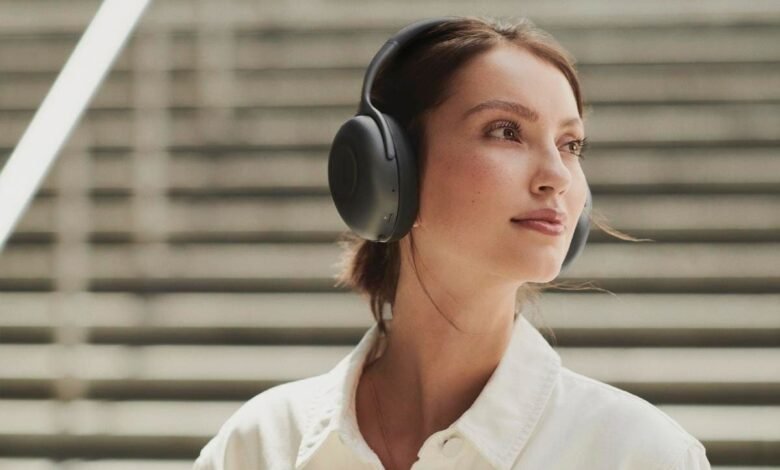KEF Mju7 Wireless Headphones Have That Signature British Sound

The KEF Mju7 wireless headphones with ANC were designed by Ross Lovegrove and have a teardrop shape. … [+]
It’s taken me a while to get my hands on a pair of KEF Mju7. Somehow, this pair of wireless ANC headphones slipped under my review radar but I thought I’d look at them, having recently been bowled over by Cambridge Audio’s Melomania P100 headphones I wondered how the Hi-Res Mju7 would compare.
KEF is one of the oldest and most traditional British speaker brands and hails from a time when the UK led the world in audio technology. Founded in the county of Kent, England, back in 1961, KEF went on to carve itself an enviable reputation for making amazing loudspeakers. Now, the brand is booming and it has even opened stunning showroom galleries around the world.
As with other speaker brands, like B+W, KEF entered the headphone space with the launch of the Mju7 a year or so ago. These wireless Bluetooth headphones are designed by Ross Lovegrove, the designer who has collaborated with KEF on products like Muon floor-standing speakers and KEF’s first wireless earbuds, the Mju3.
The Mju7 headphones from KEF have a beautiful and soft design.
As you would expect from a KEF product, the build quality of the Mju7 headphones is exemplary. Lovegrove’s design has earcups with a lovely teardrop shape. Generously upholstered earpads are covered with soft pleather and stuffed with memory foam. The earcups can rotate through 90 degrees so they can stow away flat in their zippered hard case. The headphone yoke doesn’t fold in on itself, which is no bad thing in my view and means less chance of a creaking frame.
The comfort level of the Mju7 is excellent. The clamping pressure isn’t quite as gentle as Sony’s WH-1000XM5 but they feel secure when worn. Weighing in at 309g, the Mju7 don’t feel too heavy, thanks to a padded headband and adjustable arms that make the fit snug and secure. The earpads seem to wick away any sweat and the listener’s ears remain cool. Finally, there’s a choice of Silver Grey or Charcoal Grey colorways.
It’s fair to say the Mju7 headphones aren’t exactly bristling with features but most things that you need are there. For a start, the Mju7 are built around a Qualcomm chipset that supports SBC, AAC and aptX HD. There’s no support for Qualcomm’s Snapdragon Sound Platform with the new aptX Lossless codec.
The Mju7 fold flat to fit in their hard zippered case.
The Mju7 are fine for Hi-Res listening on Android and use with iOS thanks to AAC support. However, if you want Snapdragon Sound support there are some great headphones now available like the Edifier Stax Spirit S5 and Cambridge Audio’s Melomania P100.
In each earpiece, there are 40mm custom drivers. A built-in battery provides up to 40 hours of playtime from a single charge. While that’s not exactly “best in class” it’s plenty good enough for a return long-haul flight. The use of Bluetooth 5.1 means you also get support for Multipoint connectivity, enabling two devices to be connected at the same time so you can listen to music from one device while taking phone calls from, say, your company smartphone.
Because the Mju7 headphones use Qualcomm technology, you also get cVc noise-canceling mic technology which means quieter and more intelligible speech when making phone calls or taking part in video conferences.
The KEF Mju7 headphones are available in Silver. Grey or Charcoal Grey colorways.
The microphones built into the earcups are also used for sampling sound for the Active Noise Canceling functions. A press of the ANC button turns the feature on and off, with most unwanted sounds being adequately filtered out. The Smart ANC function adapts to the level of external noise on the fly and it does a great job. Is it as good as Bose or Sony ANC? Well, not quite but it’s not bad at all.
Oddly, there’s no hear-through or transparency mode but that’s not an issue for me as I rarely use it, but for someone who wants to be aware of their surroundings when jogging or working out, it could be an issue. One handy feature I did like is the auto-pause function when you lift an earcup. It’s useful when someone talks to you; just lift an earcup and the music pauses.
The controls for the Mju7 are all located on the right-hand earcup. There’s a power switch and a Bluetooth pairing button for getting connected to your smartphone or audio player. There’s also an ANC button for turning the noise canceling on and off, plus a USB-C charging and data port.
Seen from the side, the KEF Mju7 look beautiful and stylish.
You can use the USB port for topping up the Mju7’s rechargeable battery as well as connecting the headphones to a computer via a USB data cable so you can experience a Hi-Res wired connection. For legacy connections, there is a 3.5mm AUX socket which takes a cable that can connect the headphones to a hi-fi system or digital audio player.
Next, we move on to the surface of the right earcup. There is a scooped surface that is touch-sensitive and laid out in a cruciform shape. The touchpad lets you swipe forward to the next track or swipe back to repeat the last track. You can pause and play the music with a touch and raise or lower volume levels. It works well and is one of the few touch controls on headphones that I enjoyed using.
One major omission with the Mju7 is the lack of a smartphone app for customizing things like EQ and controls. There’s also no way to update firmware. It’s an odd omission and a well-designed app can add value to a pair of wireless headphones. I think KEF has missed a trick here.
The Mju7 headphones have adaptive ANC for canceling unwanted sounds.
Now we come to the most important part of the review: how do the KEF Mju7 sound? KEF makes some great speakers and its 60+ years of audio experience can certainly be heard in these headphones. The sound is muscular and well-defined. If these headphones were human, they would have a six-pack. To audition Mju7, I streamed from TIDAL using aptX HD over Bluetooth.
Rhiannon Giddens is always a superb artist for testing for a pair of headphones. Her clear voice can give any driver a proper workout. The track “At The Purchaser’s Option” from Giddens’ Freedom Highway album was a good place to start. The Mju7 headphones handled the intro kickdrum with genuine style. It’s an exciting sound although the presentation of the track overall sounded a little laid back. That’s not necessarily a criticism but these are not headphones that will slap you around the ears and give you a headache, but they have enough drive and resolution to produce a convincing soundstage although not a particularly wide one.
There’s plenty of bass on offer with the Mju7s but things never get out of hand. Restrained in places, the sound has plenty of forward definition in the midrange which presents vocals well. It’s possibly in the crossover between the bass and lower mids where things can get a little muddy but it depends on the source. If you feed the KEF Mju7 a well-recorded track and play it on a good source, you will be rewarded with a fine sound. If you love the signature KEF sound you will know what I mean.
The fit of the KEF Mju7 is comfortable but secure thanks to soft ear cushions.
Verdict: The market for wireless ANC headphones is brutal now. It’s a competitive space and that’s largely due to Qualcomm’s superb chipsets and the help they give audio companies when designing headphones and earbuds. As a result, there are a lot of headphones out there at keen prices. KEF has never been a bargain basement brand but it has its loyal followers. If you love the KEF sound and appreciate the Ross Lovegrove style, you’re going to appreciate the Mju7. There are a few oversights such as transparency mode and the absence of an app, but if you can see your way past that, then these comfortable and clean-sounding headphones are well worth a listen even though they are a little expensive.
Pricing & Availability: The KEF Mju7 wireless ANC headphones are available now and cost $399.99 / £349 / €399.
Tech Specs:
- Drivers: 40mm.
- Max power output: 15mW.
- Bluetooth version: 5.1.
- Codecs: SBC, AAC, aptX, aptX HD
- Bluetooth power: Class 2.
- Bluetooth range: 10m.
- Battery: 1,100mAh.
- Battery life: 40 hours (BT + ANC on).
- Fast charging: 15 minutes = 8 hours.
- Dimensions (H x W x D): 199 x 153 x 89mm.
- Weight: 309g.




